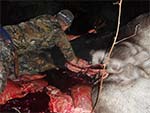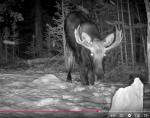Moose Field Dressing
The pictures contained on this page are from moose field dressing in real life.
Warning: The images (blood & guts) contained on this page may be offensive to some viewers.
Moose Field Dressing requires the removal of the entrails. I’ll try and explain this process the best I can and supplement with pictures.
After ensuring your moose is dead (the best way is to poke it in the eye, any reaction means there is some life - use caution), roll it or move it in such a way that as you remove the entrails they will roll downhill away from the moose.
To make sure the moose is dead, be sure its eyes are open.
Next, poke it in the eye and watch for any reaction, if for any reason you believe the animal has not expired, it is best to wait a few more minutes. It would be a terrible thing (not only dangerous) to have your moose get up and run away, while you stand there with your hunting knife in hand.
How would you explain that to your hunting buddies?
Can you imagine your face, that would be a jaw dropping experience! "Really, I was just about to do my moose field dressing and it stood up... just kind of stared at me, then took off like a scared rabbit. What could I have done? Attacked it like Rambo or something?"
One of the neatest tools I have come across for moose field dressing is the Wyoming Knife. The knife makes cutting the skin and then the stomach lining a cinch. You don’t have to worry about puncturing the stomach (big smelly mess) using this tool.
Read our Wyoming Knife review.
I have used my Wyoming Knife since I purchased it in the early 1980’s to clean countless big game animals. Replacement blades are inexpensive and easy to change... although I have only had to replace mine twice. They do stay sharp a long time. I use this knife for skinning too!
Rather watch this on video? Moose Field dressing Video
Moose Field Dressing Steps
Notice how I have tied one leg back to a tree with a rope for ease of
access to the moose chest area; I have cleaned many moose by myself
this way. You can substitute a log or a bush if there is not a tree
available. Of course you can always have your hunting partner hold the
leg.
 |
 |
 |
Cut Open the Abdomen
The first step I do is carefully make an incision large enough for the tip of the Wyoming knife with my hunting knife just deep enough to cut the skin without cutting the abdomen. I then insert the Wyoming knife and cut towards the head of the moose along the chest centerline. I only cut as far as the lower edge of the ribcage.
Some hunters cut to the top of the ribcage, just below the neck; facilitating the cutting open of the ribcage.
We save this step until we return to camp, and for good reason. Every time you make an incision through the moose hide, you leave an area of meat or membrane that will attract dirt or other debris. I have found that the splitting of the ribcage in the field is an unnecessary step unless you have to pack your animal, in which case you must.
Next is the Wyoming Knife in action. The initial incision made, I insert the knife to cut the hide.
Next, using my Buck knife I cut through the stomach muscles, using the Wyoming knife I cut again toward the lower part of the ribcage.
As you make your cut the pressure inside the moose will cause the entrails to push out through the incision.
 |
 |
 |
The Butt Out tool ready for insertion.
Insert then twist until tight.
Pull slowly, until enough of the anal membrane has been extracted then tie.
Moose Hunting Tips Book
This section on moose field dressing is included in our moose hunting tips book - The Ultimate Guide to Moose Hunting
Get your copy today.
Butt Out Tool - Review
Another interesting tool that I am trying out for moose field dressing is the Butt Out tool.
I have used it with success on deer but I have had limited success using it on moose. The tool seems to be too small in diameter to be used effectively on a moose, maybe the extra long one would work better. To use this tool you should insert it into the rectal canal, twist until tight, then pull with a steady force. Pull about 10 inches of the anal cavity out... I am not so sure about this distance.
You will see in my pictures that I tie off the anal cavity using tie wraps, a quick and easy way when your hands are slippery.
According
to the directions you do not need to cut around the anus, but I have
found I still need to do this to free up the whole thing.
Be careful doing this step you do not want to cut the anal canal or puncture the bladder.
I have used this device on four moose to date and I will try one more time before I relegate it to deer hunting only.
If you have had any success (or not) using the Butt Out tool for moose field dressing we would appreciate the feed back.
Update: Butt Out now is available in an extra long size. This should make the process on moose much easier. Also comes in a complete kit.
 |
 |
 |
Carefully cut around the anus to free it from the body. Use a sharp knife with a narrow blade for this operation, a skinning knives blade will be too wide.
To Remove Entrails
Reach in to the stomach cavity and pull the anus through, while being careful not to break the bladder. While moose field dressing I have not bothered with wearing any type of glove, they tend to get torn on the sharp edges of bone and fill with blood anyway.
Pull the entrails out of the cavity.
Use a sharp knife to cut the entrails away from the back. Keep working at this until you reach the diaphragm.
Lastly will be the heart and lungs. This is where some hunters might say they would split open the ribcage for access during moose field dressing. Just remember this... dirt, gravel and pine needles do not add any good flavours to your meat.
I do this last operation by feel; very carefully. Reach into the chest cavity (without your knife in hand) and feel for the esophagus, you have to reach this with knife in hand and sever it.
This is a bit tricky, but I have done this successfully on twenty five moose and over twenty deer. Just be careful and pay attention to where your knife is. Oh... did I mention that this will likely be a one handed job.
If you are feeling a little apprehensive about tackling this job, maybe a video on field dressing big game would help.
 |
 |
 |
Cutting through the diaphragm
The diaphragm separates the lungs and heart from the stomach, once you reach the diaphragm you must puncture it and cut it away from the rib cage. The diaphragm fully encompasses the moose, therefore it will take some effort to reach and cut it all away.
Moose liver in hand, heart and lungs yet to remove.
Before cutting the esophagus, I am reaching up inside to feel where to cut. Note: my knife in my left hand while I investigate.
My preferred knife for this job is the Buck Knife.
After all entrails are removed, either turn the carcass over or move the rear end of the moose downhill to allow the excess blood to drain.
Moose field dressing is one of those chores of hunting that must be done. I do not mind doing it, as a matter of fact I like doing it. When my partners and I get a moose I usually elbow my way in and do the cleaning, although I do not really mean too, it just happens that way!
All Done
 |
 |
Seventy two hours after we cleaned the moose, the area has been
completely cleaned up by scavengers. The entrails will have fed a host
of animals in the forest.
Back at camp we have the task of skinning our moose. Watch this video to see how we skin our moose.
All the effort pays off. This is our meat hanging in the cooler to age.
Aging moose meat is important in the tenderizing process. We age our meat by hanging it in a meat cooler, usually for about ten days (depending on how many days it hung in camp). We check it every day, then when it just begins to sweat, we will butcher it.
Another important note: Whenever possible we complete our moose field dressing near the point where we will load the meat. That is to say, we drag our moose close to the road or trail first. How can we drag a moose you ask? We carry over 3000 feet of rope with us to assist with the task.
Read what others have to say about Moose Hunting by clicking here.
Want to learn how to hunt moose? Or are you wanting to increase your moose hunting skills?
Look no further!
Our moose hunting tips book is written with
not just the novice in mind, there are tips in the book that even the
most seasoned moose hunter will find of value.
The book includes 57 chapters, with more than 150 pages of information, jam packed with tips, techniques and discussions - The Ultimate Guide to Moose Hunting!
And don't forget to order one of our Fiberglass Moose Calls. In stock and ready to ship.
Top of Moose Field Dressing Page








Comments
Have your say about what you just read! Leave me a comment in the box below.